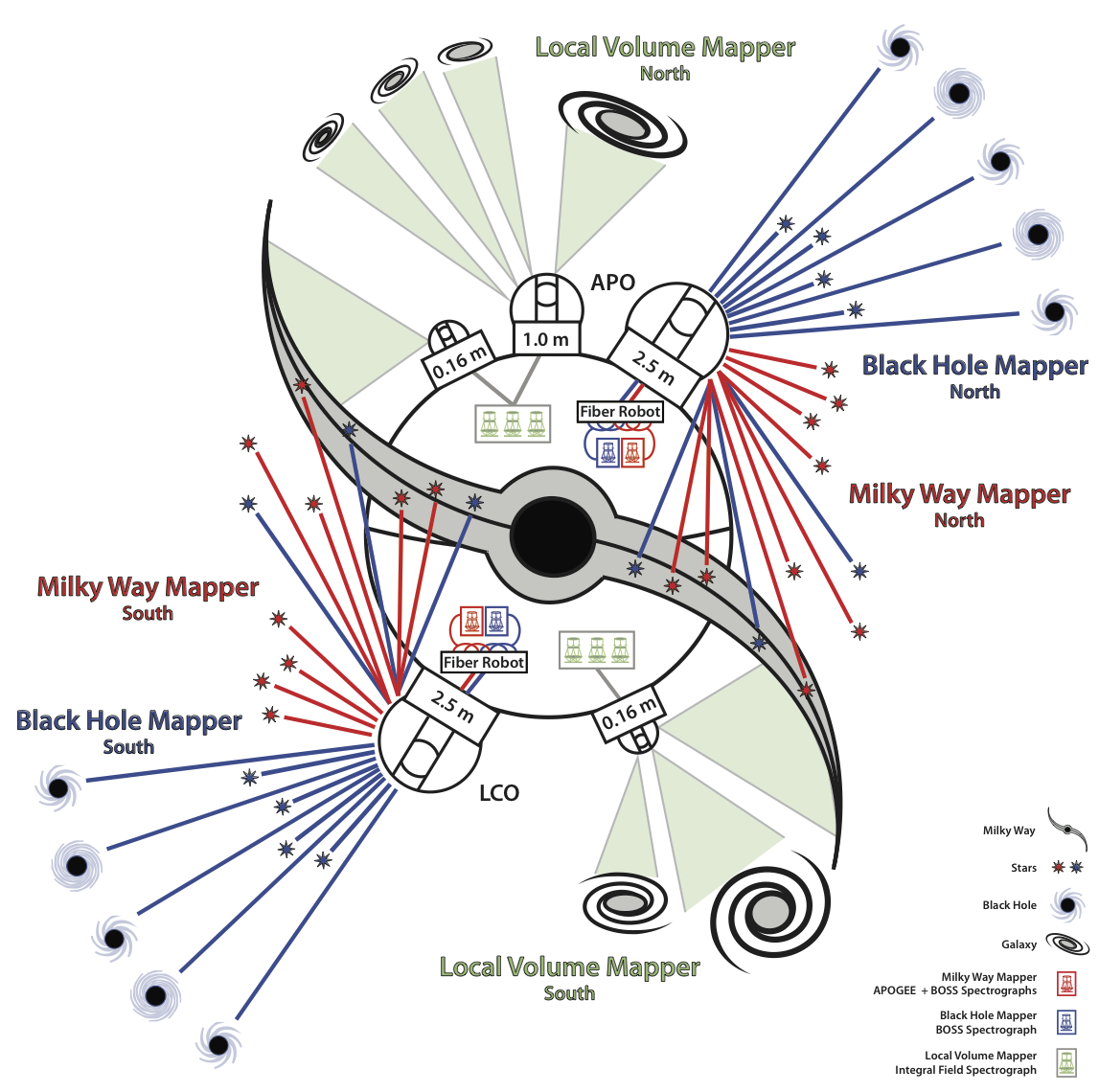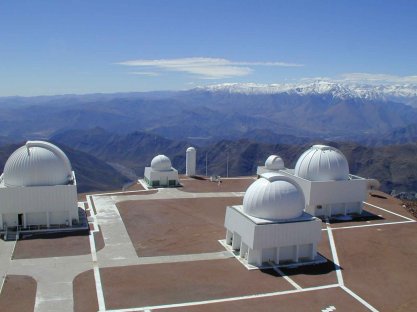Facilities for VIDA research
 Sloan Digital Sky Survey (SDSS)
Sloan Digital Sky Survey (SDSS)
Vanderbilt has participated in SDSS since SDSS-III, and is now a leader in the current SDSS-IV and upcoming SDSS-V surveys. SDSS-V comprises three key programs, called Mappers:
- The Milky Way Mapper (MWM) will target 4-5 million stars across the Milky Way, collecting infrared spectra with an APOGEE spectrograph and/or optical spectra with a BOSS spectrograph. The MWM seeks to understand the evolution of the Milky Way, the physics of its stars and interstellar medium, and the architecture of multiple-star and planetary systems.
- The Black Hole Mapper (BHM) will target over 400,000 sources, primarily black holes, with a BOSS optical spectrograph. Many of these will be observed numerous times, with the goal of measuring black hole masses, probing black hole growth across cosmic time, and characterizing the X-ray sky.
- The Local Volume Mapper (LVM) will observe the interstellar medium and stellar populations in the Milky Way and several local galaxies, collecting more than 25 million contiguous spectra over 3,000 square degrees on the sky. The LVM will use new integral-field spectrographs to explore the physics of star formation and the interactions between stars and the interstellar medium.
SMARTS: Research Telescopes for Time-Domain Astronomy
The Small and Moderate Aperture Research Telescope System (SMARTS) Consortium operates four telescopes at the Cerro Tololo Inter-American Observatory (CTIO) in the Chilean Andes. Vanderbilt's share on the SMARTS telescopes is approximately 70 nights per year. This access allows dedidated surveys of very large numbers of astrophysical objects over long periods of time, which has allows VIDA researchers to discover rare classes of stars that help us understand how stars form. SMARTS is also a primary location for training of graduate and undergraduate students in observational astronomy.
REDDnet: Enabling Data Intensive Science in the Wide Area
 REDDnet (Research and Education Data Depot network) is an NSF-funded infrastructure project designed to provide a large distributed storage facility for data intensive collaboration among the nation's researchers and educators in a wide variety of application areas. Its mission is to provide "working storage" to help manage the logistics of moving and staging large amounts of data in the wide area network, e.g. among collaborating researchers who are either trying to move data from one collaborator (person or institution) to another or who want share large data sets for limited periods of time (ranging from a few hours to a few months) while they work on it.
REDDnet (Research and Education Data Depot network) is an NSF-funded infrastructure project designed to provide a large distributed storage facility for data intensive collaboration among the nation's researchers and educators in a wide variety of application areas. Its mission is to provide "working storage" to help manage the logistics of moving and staging large amounts of data in the wide area network, e.g. among collaborating researchers who are either trying to move data from one collaborator (person or institution) to another or who want share large data sets for limited periods of time (ranging from a few hours to a few months) while they work on it.
ACCRE High-Performance Computing Center
The Advanced Computing Center for Research and Education (ACCRE) at Vanderbilt is central to VIDA's work. Key features of ACCRE for VIDA research include:
- 1500 nodes: 2 GHz processors, 2 Gb memory
- 1.5 Tb/s bandwidth, 10 Gb/s intake capability (new record)
- Data-intensive applications: ½ Pb work space, 200 Tb long-term data storage, including L-Store capability in the near future
- User support (help with parallelizing code, etc)
- Special graduate course in high-performance computing
TeraGrid
 TeraGrid is a NSF-funded open computational resource that consists of supercomputers at eleven partner sites: Indiana University, the Louisiana Optical Network Initiative, the National Center for Atmospheric Research, National Center for Supercomputing Applications, the National Institute for Computational Sciences, Oak Ridge National Laboratory, Pittsburgh Supercomputing Center, Purdue University, San Diego Supercomputer Center, Texas Advanced Computing Center, and University of Chicago/Argonne National Laboratory. Currently, TeraGrid resources include more than 750 teraflops of computing capability and more than 30 petabytes of online and archival data storage, with rapid access and retrieval over high-performance networks. TeraGrid computing time has been awarded to VIDA researchers for the LasDamas project.
TeraGrid is a NSF-funded open computational resource that consists of supercomputers at eleven partner sites: Indiana University, the Louisiana Optical Network Initiative, the National Center for Atmospheric Research, National Center for Supercomputing Applications, the National Institute for Computational Sciences, Oak Ridge National Laboratory, Pittsburgh Supercomputing Center, Purdue University, San Diego Supercomputer Center, Texas Advanced Computing Center, and University of Chicago/Argonne National Laboratory. Currently, TeraGrid resources include more than 750 teraflops of computing capability and more than 30 petabytes of online and archival data storage, with rapid access and retrieval over high-performance networks. TeraGrid computing time has been awarded to VIDA researchers for the LasDamas project.
Hereford Arizona Observatory
 The Hereford Arizona Observatory (G95) consists of 11-inch Celestron and 14-inch Meade telescopes that are fork-mounted on equatorial wedges. Buried cables allow an office computer to control the telescopes and dome movement for unattended, all-night observing sessions. The observatory is owned and operated by Mr. Bruce Gary, an amateur astronomy with years of experience and active involvement in the American Association of Variable Star Observers. An example of the involvement of "citizen scientists" in mission-critical aspects of ground-breaking science, Mr. Gary is a core part of the VIDA search for exoplanets, with an impressive capability of photometry at the sub-millimagnitude level.
The Hereford Arizona Observatory (G95) consists of 11-inch Celestron and 14-inch Meade telescopes that are fork-mounted on equatorial wedges. Buried cables allow an office computer to control the telescopes and dome movement for unattended, all-night observing sessions. The observatory is owned and operated by Mr. Bruce Gary, an amateur astronomy with years of experience and active involvement in the American Association of Variable Star Observers. An example of the involvement of "citizen scientists" in mission-critical aspects of ground-breaking science, Mr. Gary is a core part of the VIDA search for exoplanets, with an impressive capability of photometry at the sub-millimagnitude level.